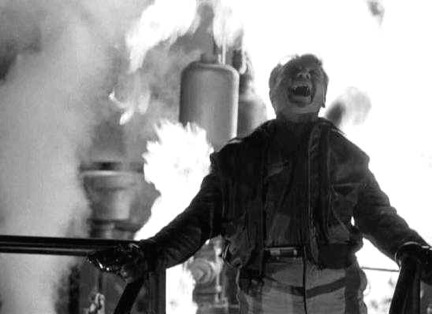 James Cagney has always been my favorite actor, but it took Orson Welles to explain why. Hearing the auteur admire him in the 1988 profile With Orson Welles: Stories from a Life in Film (why isn't this wonder on DVD?!), I finally understood Cagney's visceral appeal in cerebral terms: "What is more unreal and stylized than Cagney? It's a totally stylized, unreal performance. No human being ever behaved the way he does. And every moment of Cagney's entire life in films is truth. He never had a second that wasn't true."
James Cagney has always been my favorite actor, but it took Orson Welles to explain why. Hearing the auteur admire him in the 1988 profile With Orson Welles: Stories from a Life in Film (why isn't this wonder on DVD?!), I finally understood Cagney's visceral appeal in cerebral terms: "What is more unreal and stylized than Cagney? It's a totally stylized, unreal performance. No human being ever behaved the way he does. And every moment of Cagney's entire life in films is truth. He never had a second that wasn't true."
That's certainly confirmed in the bookend films of Tuesday night's Turner Classic Movies tribute to Public Enemies: The Golden Age of the Gangster, which is also the title of a new 8 p.m. documentary about what may be my favorite classic film genre.
After narrator Alec Baldwin lays out the case, the evidence follows:
- 9:45 p.m. -- The Public Enemy (1931), Cagney's breakthrough film about an ill-fated Prohibition bootlegger, directed like a fusillade by William Wellman.
- 11:15 p.m. -- The Amazing Doctor Clitterhouse (1938) -- Edward G. Robinson as a scientist flirting with the dark side to better study crime, as embodied by star-to-be Humphrey Bogart.
- 12:45 p.m. -- Invisible Stripes (1939) -- George Raft gets out of the joint, just as younger brother William Holden is acting up to go in, with help from Bogart.
- 2:15 a.m. -- Larceny Inc. (1942) -- Edward G. again, this time comedically discovering that getting out of crime might pay just as well.
- 4 a.m. -- White Heat (1949) -- A coda for the '30s gangster generation, speeding toward modernity. Cagney leads a small-time gang with his mother, to whom he has a strange psychological attachment.
Cagney continually rips the roof off the sucker in that finale, directed by Raoul Walsh toward a literally explosive climax. But their film was figurately putting a period to the dwindling gangster genre. It had been born out of the post-World War prohibition and Depression, at precisely the moment that budding sound movies needed its force, fury and chatter -- both human and Tommy-gun. By 1949, a more complex society was emerging out of the Second World War, to be defined more by the guy in the grey flannel suit than the street thug.
TCM's lineup of public enemies is easy to quibble with -- no Little Caesar, no Scarface, no Roaring Twenties? -- but also easy to enjoy. Consider it a primer for one of the most robust movie genres, and also one of the most relevant, reflecting the sociology of the time as much as the egos of its exponents -- and legendary portrayers.